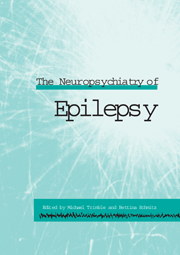Book contents
- Frontmatter
- Contents
- List of contributors
- Part I Background
- Part II Clinical aspects
- 4 The psychiatry of idiopathic generalized epilepsy
- 5 Epilepsy and learning disorders
- 6 Subtle cognitive and behavioural effects of epilepsy
- 7 Aggression and epilepsy
- 8 Epilepsy and suicide: a neuropsychiatric analysis
- 9 Postictal psychoses, revisited
- Part III Cognitive aspects
- Part IV Nonepileptic attacks
- Part V Treatment complications
- Part VI Treatment
- Index
9 - Postictal psychoses, revisited
Published online by Cambridge University Press: 05 October 2010
- Frontmatter
- Contents
- List of contributors
- Part I Background
- Part II Clinical aspects
- 4 The psychiatry of idiopathic generalized epilepsy
- 5 Epilepsy and learning disorders
- 6 Subtle cognitive and behavioural effects of epilepsy
- 7 Aggression and epilepsy
- 8 Epilepsy and suicide: a neuropsychiatric analysis
- 9 Postictal psychoses, revisited
- Part III Cognitive aspects
- Part IV Nonepileptic attacks
- Part V Treatment complications
- Part VI Treatment
- Index
Summary
Historical background
Except for the immediate effects of a seizure on mental function, such as complex partial status epilepticus and postictal confusion, modern epileptic psychoses can be categorized into three main types: chronic, acute interictal and postictal psychoses. In 1953, Landolt stressed a seesaw relationship between epileptic seizures and psychoses, and proposed the concept of forced normalization. In 1963, Slater made a rather comprehensive report on chronic psychoses in patients with epilepsy (Slater and Beard, 1963). In contrast, it was as late as 1988 before the concept of postictal psychoses was revived by Logsdail and Toone. This delay in conceptual formation is all the more peculiar, when considering the very old root of the concept of postictal psychosis.
In 1860, a French psychiatriat, Farlet, classified epileptic psychoses into three categories: transient peri-ictal, chronic and true epileptic psychosis (Farlet, 1860/1961). As there was a lack of strict distinctions between preictal, intraictal and postictal events at that time, it is not easy to compare Farlet's classification to those of the present. While transient peri-ictal psychosis overlaps postictal confusion and the meaning of chronic psychosis is evident, Farlet's true epileptic psychosis has no clear counterpart in modern classifications. Farlet assigned extreme psychomotor agitation as well as extraordinarily aggressive and self-destructive behaviour to his unique classification. As I will discuss later, these are salient psychopathological traits of postictal psychoses. Indeed, John Hughlings Jackson (1875), a pioneer of modern epileptology, stressed that the true epileptic psychosis described by Farlet often followed clusters of seizures.
- Type
- Chapter
- Information
- The Neuropsychiatry of Epilepsy , pp. 117 - 132Publisher: Cambridge University PressPrint publication year: 2002
- 18
- Cited by

